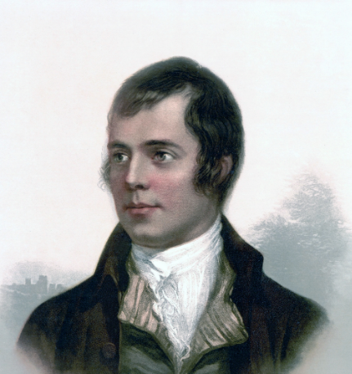As Burns Night approached and the people of Scotland were eagerly awaiting their wee dram of whisky, the Applications team wondered what a dram would look like when a laser is shone onto it. For those of you not up to scratch on your Scots knowledge a ‘wee dram’ is the perfect pour of whisky, and on the 25th of January across Scotland we raise a glass to celebrate the life of one of our most famous poets and writer of Auld Lang Syne, Robert Burns.

Figure 1: Robert Burns
Figure 2 shows the spectrum of a sample of Glenlivet 15 Malt Whisky acquired on an Edinburgh Instruments RM5 Raman Microscope with a cuvette holder attachment. The most significant peaks are from ethanol in the whisky. More subtle peaks and their shape provide distinguishing features which can be used to separate different brands and ages of whisky.

Figure 2: Raman spectrum of Glenlivet 15 whisky
More sinisterly, many news stories have emerged over the years highlighting the danger of methanol spiked alcoholic beverages, specifically spirits such as vodka and whisky. Alcohol we buy and consume should contain a percentage of ethanol, this is the percentage marked on the bottle, for example a bottle of Scottish whisky may be marked at 40% abv. This means 40% of the volume should be ethanol. Methanol meanwhile is toxic to humans, and is commonly found in antifreeze. The two molecules only differ by one carbon and two hydrogen atoms, Figure 3. Fraudulent drinking spirits have been produced containing methanol to decrease the price of manufacture, often leading to illness and fatalities. Of note, since October 2020 Costa Rica has reported at least 54 deaths caused by methanol poisoning. In this case a sugarcane distillate called guaro that has been illegally adulterated with methanol is the culprit. An official list of liquor brands has been published by the government to advise the public which brands to avoid to prevent themselves consuming the dangerous methanol.1

Figure 3: Methanol and ethanol’s chemical structure
Ethanol metabolises in the liver by a process called alcohol dehydrogenase eventually being broken down to harmless carbon dioxide and water. With methanol, the alcohol dehydrogenase enzyme converts the methanol into formaldehyde which is then rapidly metabolised into formic acid. According to the toxicological overview from Public Health England, methanol is toxic following ingestion, inhalation, and via dermal exposure. The potential effects from methanol poisoning range from, but are not limited to, central nervous system depression, nausea, blindness, coma, and death.2
Raman spectroscopy can detect when alcoholic beverages have been adulterated with methanol. Figure 4 shows the spectra of methanol, whisky, and a whisky sample spiked with methanol. From the spectrum we can clearly see the influence of the addition on methanol to this whisky spectrum between 1000 cm-1 and 1100 cm-1.

Figure 4: Raman spectra of methanol, whisky, and whisky spiked with methanol
Unfortunately, fraudulent food and beverages are a continuing global issue, and some of these can have fatal consequences. Here we show how Raman spectroscopy can be utilised to detect such adulterants and keep consumers safe. If you are interested in finding out more about how Raman spectroscopy can help you ensure food and drink safety standards, our recent Application Note details Raman spectroscopy being used for the detection of fraudulent extra virgin olive oils using an RMS1000 Raman Microscope.

1. Death toll rises to 54 due to liquor adulterated with methanol. The Tico Times
2. Public Health England. Methanol Toxicological Overview Key Points Health effects of chronic exposure. (2015).
If you are working in the field of Raman Spectroscopy, our Raman Confocal Microscope may be the perfect partner for your Raman research.
For further information please Contact Us.
If you have enjoyed reading this article, why not sign up to our monthly newsletter via the button below or follow us on LinkedIn, Twitter or Facebook to keep up to date with our latest news and research.

No results found.
No results found.